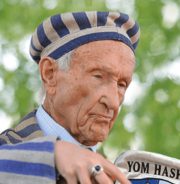USC Shoah Foundation facts for kids
| Founded | 1994 by Steven Spielberg in the United States |
|---|---|
| Type | Research and Education Institute |
| Headquarters | University of Southern California |
| Location | |
|
Key people
|
Dr. Robert Williams (Executive Director), Joel Citron (Board Chair) |
The USC Shoah Foundation is a non-profit group that records video interviews with survivors and witnesses of the Holocaust. The word for the Holocaust in the Hebrew is Shoah. The foundation's full name is the USC Shoah Foundation – The Institute for Visual History and Education.
Famous director Steven Spielberg started the foundation in 1994. He created it one year after his award-winning movie Schindler's List was released. In 2006, the foundation moved to the University of Southern California (USC).
The foundation's main goal is to save the stories of people who experienced terrible events called genocides. A genocide is when a group of people is targeted and killed. By recording their memories, the foundation helps make sure that we never forget what happened.
Contents
The Visual History Archive
The foundation keeps all its interviews in a huge digital library called the Visual History Archive. This archive holds the personal stories of people from many different backgrounds. It started with the Holocaust but has grown to include other events.
What's in the Archive?
The archive is a collection of powerful stories told by the people who lived them.
- Video Testimonies: The foundation has recorded over 55,000 video interviews. Most are about the Holocaust and include Jewish survivors, people who rescued them, and soldiers who freed the camps. The archive also includes stories from survivors of other genocides, such as those in Rwanda, Armenia, Cambodia, and Guatemala.
- Stories from Today: The foundation also interviews people who are witnessing violence in the world right now. They hope that by sharing these stories, they can help stop violence before it turns into a genocide. They have collected stories from places like South Sudan and Syria.
- Dimensions in Testimony: This is a special project that creates 3D interactive videos of survivors. You can ask questions and hear the survivor answer in real-time, almost like you're talking to them. It helps people connect with history in a very personal way.
- Testimony on Location: For this project, survivors are interviewed in the actual places where their stories happened. Using 360-degree cameras, viewers can feel like they are standing in a former concentration camp or a childhood home while hearing the survivor's story.
History of the Foundation
The USC Shoah Foundation was started by director Steven Spielberg in 1994. After making the film Schindler's List, he felt it was important to save the real stories of Holocaust survivors. His goal was to record at least 50,000 interviews.
In 2006, the foundation moved to the University of Southern California. This partnership helped the foundation grow. In 2014, it created the Center for Advanced Genocide Research. This center studies why genocides happen and how they can be prevented.
The foundation has also collected stories about more recent events. After the October 7 attacks on Israel, researchers went to Israel to record the stories of survivors and witnesses. This is part of their mission to document history as it happens.
Research and Learning
The foundation doesn't just collect stories; it also helps people learn from them. The Visual History Archive is used by students and teachers all over the world.
The Center for Advanced Genocide Research is the part of the foundation that studies the causes of genocide. Researchers look for patterns and try to understand how to stop mass violence. They hold meetings and invite experts from around the world to share ideas.
For example, the center has studied how music can be used to resist violence and oppression. By understanding the past, they hope to help create a better future.
Education Programs
The foundation has created many programs to help students and teachers use these powerful stories in the classroom.
- IWalks: This program is like a walking tour that uses your phone. As you walk through cities like Prague or Warsaw, you can watch video clips of survivors telling their stories about the very places you are standing.
- ITeach: This is a one-day training for teachers. It shows them how to use the video testimonies to teach students about history and human behavior.
- Echoes and Reflections: This program gives teachers in the United States tools and materials to teach about the Holocaust. It helps students understand this difficult part of history through the stories of those who lived it.
Sharing Stories with the World
The foundation wants to make sure these stories reach as many people as possible. The full Visual History Archive can be accessed at 49 universities and museums around the world.
The foundation also works with TV channels and websites to share documentaries and other programs. They use social media to spread awareness and fight against hatred. One of their campaigns, called #strongerthanhate, gives people tools to stand up against prejudice and bullying in their own communities.
By sharing these personal accounts of survival and courage, the USC Shoah Foundation helps us all remember the past and work for a more peaceful world.


